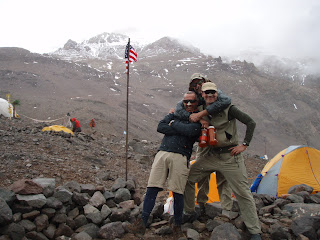When we first arrived at Base Camp at the start of our trip we were tired and hungry, and after we set up camp we opted to eat in the mess tent maintained by Aconcagua Trek - our muleteers. The mainstay of Aconcagua Trek, as well as numerous other companies, is guiding in addition to providing other logistical services. The first person we met on our arrival was Veronika - chief cook, logistician and ombudsman for Aconcagua Trek. In a cheerful mix of English and Spanish we determined such important information as where to pitch our tent, the location of the key for the toilet, where and how to collect water, etc. During the times we were in Base Camp Veronika helped us with sat-phone calls, internet access, and other essential tasks, but never during siesta time - about 1:30 - 4:30 pm, when she would be sleeping on a mattress in the back of the communications tent!
 |
| Steve, Veronika and Ben in Base Camp |
That first night at dinner in the mess tent we also met Fernando and Mariana - two guides working with an outfitter that was somehow associated with Aconcagua Trek. Fernando had Latin-pop-singer good looks and was open, charming and engaging - he told us he had summited the mountain eight times, and this was his first trip of the season. Mariana had only summited once, and this was her first working trip after having attended guide training school - her continual banter and teasing belied nervousness at her new responsibilities. Their six or eight clients were a potpourri of aspirants - "Quebec," a young woman from Quebec City and her boyfriend; Serge, from the Champagne region of France; Pat, a professor of dermatology from Louisiana; and several others. We shared dinner and conversation with all of them, and Fernando was generous with his encouragement, suggestions and candor.
In our weeks on the mountain, we found that indeed most ascent attempts are guided. Not only do the guiding companies provide route-finding, they also provide many other services such as meal preparation, melting snow for drinking water, setting up tents, etc. Most guided groups hire porters who do all this work plus carry gear from one camp to the next. We and the several other groups of unguided climbers were afforded a certain measure of respect by our fellow climbers because the physical act of climbing is but a small fraction of what is necessary to sustain an expedition.
 |
| Our tent at Camp Colera |
Once a day's climbing is done, the tent must be pitched - often in high winds or snow; stoves must be lit for melting snow or ice for drinking water; and a meal must be prepared. At temperatures of 0 - 15 deg. F the process of collecting and melting snow and (sometimes) filtering water may take 2 1/2 - 3 hours or longer. Boiling water for meals takes a similarly long time, and once all these chores are done it was typically after dark and getting very cold. There were numerous times that we were more than envious of the guided groups who arrived at camp to pitched tents, filled water bottles, hot tea, and meals other than freeze-dried Mountain House cuisine!
From our observations, guided clients slept two-to-a-tent in good 3-4 person tents. Because managing weight was critical to us, we carried one 3-person tent. It is said that one of the most critical elements of expedition planning is in choosing the team participants, and we have a laser-keen appreciation of that! For greater than a two week period, we shared a 4 x 7 foot tent which we occupied for more than 12 hours per day, had no access to showers, and wore the same clothing for days or weeks at a time! Tolerance, a propensity to see humor in many situations, and a commitment to the end goal were all qualities that were necessary and tested! (It can be reported that we enjoyed one another's company experiencing Mendoza once off the mountain!).
 |
| Sharing a meal of Parma ham, cheese and crackers in our cozy tent |
We were on roughly the same ascent schedule as Fernando and Mariana's team and we ended up climbing from Nido de Condores to Camp Colera on the same day - the day was windy and snowy and Fernando was once again helpful with route-finding assistance, and exhibited an outward confidence and joy at his task. Though the following day, January 10 dawned clear, it had snowed 10 - 12 inches (25 - 30 cm) overnight, high winds drifted the snow and the summit appeared to be beset by the infamous Vientes Blancos (White Winds). We talked with some of the other parties, and all agreed that a summit attempt on this day would not be prudent. So we were presented with the opportunity to acclimatize one further day at 19,600 ft (5,970 m)!
By the morning of summit day, January 11, Fernando and Mariana's clients had been reduced to only Serge, the others having succumbed to AMS, inability to eat, cold, or some other malady associated with high altitude expeditions. We knew by then that the role of multiple guides is as much to accompany clients off the mountain as anything else (junior guides likely get few summit opportunities). Fernando and Serge set out a bit earlier than we on that morning, and we heard Serge's French-accented victory whoop from the summit not 20 minutes before we achieved it. Heartfelt high fives and hugs were shared between our party and Fernando & Serge as they surrendered the cumbre and we ascended it.
 |
| Steve, Fernando, Ben and Serge back in Base Camp after successfully summiting |
- Posted using BlogPress from my iPhone






















